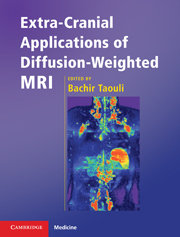Book contents
- Frontmatter
- Contents
- List of contributors
- Preface
- 1 Basic physical principles of body diffusion-weighted MRI
- 2 Diffusion-weighted MRI of the liver
- 3 Diffusion-weighted MRI of diffuse renal disease and kidney transplant
- 4 Diffusion-weighted MRI of focal renal masses
- 5 Diffusion-weighted MRI of the pancreas
- 6 Diffusion-weighted MRI of the prostate
- 7 Breast applications of diffusion-weighted MRI
- 8 Diffusion-weighted MRI of lymph nodes
- 9 Diffusion-weighted MRI of female pelvic tumors
- 10 Diffusion-weighted MRI of the bone marrow and the spine
- 11 Diffusion-weighted MRI of soft tissue tumors
- 12 Evaluation of tumor treatment response with diffusion-weighted MRI
- 13 Diffusion-weighted MRI: future directions
- Index
- References
2 - Diffusion-weighted MRI of the liver
Published online by Cambridge University Press: 10 November 2010
- Frontmatter
- Contents
- List of contributors
- Preface
- 1 Basic physical principles of body diffusion-weighted MRI
- 2 Diffusion-weighted MRI of the liver
- 3 Diffusion-weighted MRI of diffuse renal disease and kidney transplant
- 4 Diffusion-weighted MRI of focal renal masses
- 5 Diffusion-weighted MRI of the pancreas
- 6 Diffusion-weighted MRI of the prostate
- 7 Breast applications of diffusion-weighted MRI
- 8 Diffusion-weighted MRI of lymph nodes
- 9 Diffusion-weighted MRI of female pelvic tumors
- 10 Diffusion-weighted MRI of the bone marrow and the spine
- 11 Diffusion-weighted MRI of soft tissue tumors
- 12 Evaluation of tumor treatment response with diffusion-weighted MRI
- 13 Diffusion-weighted MRI: future directions
- Index
- References
Summary
Introduction
With recent advances in technology, diffusion-weighted MRI (DWI) is reaching potential for clinical use in the abdomen, particularly for the assessment of focal and diffuse liver diseases. DWI is an attractive technique for multiple reasons:
It can potentially add useful information to conventional imaging sequences.
It is quick (it could be performed within a breath-hold) and can be easily incorporated to existing protocols.
It does not require intravenous contrast administration, thus is easy to repeat, and useful in patients with severe renal dysfunction at risk of nephrogenic systemic fibrosis (NSF).
This chapter will discuss the applications of DWI applied for the diagnosis of diffuse and focal liver diseases.
Liver diffusion imaging acquisition and processing
DWI acquisition techniques
Single-shot echo-planar imaging (SS EPI) is the most frequently used sequence in combination with fat-suppression (e.g., spectral attenuated inversion recovery or chemical excitation with spectral suppression). Most diffusion studies have been conducted on 1.5-T MR systems, although there is a growing interest in performing such studies with 3-T systems due to increased availability and potential for improved image quality. DWI of the liver is usually performed prior to contrast material administration, although performing DWI after the administration of gadolinium-DTPA did not appear to significantly affect apparent diffusion coefficient (ADC) calculations in a prior study.
Imaging may be performed in breath-hold which attempts to freeze motion or in free breathing with multiple signal averaging to reduce the effects of motion. Image acquisition in free breathing may also be combined with respiratory triggering.
- Type
- Chapter
- Information
- Extra-Cranial Applications of Diffusion-Weighted MRI , pp. 18 - 31Publisher: Cambridge University PressPrint publication year: 2010



